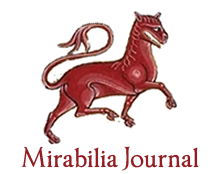The Virgin of the Annunciation: A Paradigm of Humility in Medieval Doctrine and Imagery
José María SALVADOR GONZÁLEZ
Original title: La Virgen de la Anunciación, un paradigma de humildad en la doctrina y la imagen de la Edad Media
Published in Emotions in the Ancient and Medieval Mediterranean World
Keywords: Annunciation, Humility, Iconography, Medieval Art, Patrology.
In recounting the event of the Annunciation, the Gospel of Luke describes the sublime lesson of humility given by the Virgin Mary by proclaiming herself the Lord’s slave while she received the announcement of her election as Mother of God. Such a moral stance soon became an outstanding example of modesty and obedience for all Christians, as it was showed by many Church Fathers, theologians and religious thinkers throughout the centuries. Our paper aims to highlight that this significant lesson of humility and submission by the Virgin, reported by the Gospel and frequently interpreted in patristics and theological sources, often reflected also in art works, as we try to put evident through the analysis of twelve medieval paintings.
The anagogical contemplation in Saint-Denis Abbey (XII century)
Ricardo da COSTA, Tainah Moreira NEVES
Original title: A contemplação anagógica na Abadia de Saint-Denis (séc. XII)
Published in Art, Criticism and Mysticism
Keywords: Medieval Art, Medieval Philosophy, Saint-Denis, Suger.
“Bright is the noble work; but, being nobly bright, the work should brighten the minds, so that they may travel, through the true lights, to the True Light where Christ is the true door”. This phrase was inscribe by orders of Abbot Suger (c. 1081-1151) in one of Saint-Denis Abbey’s bronze doors. It emphasizes the anagogical character, provided by Suger to art, at the basilica’s reconstruction. In this philosophical and religious process, described by Pseudo-Dionysius the Areopagite, in the fifth century, the medievals ascend from the physical light, the material, to the spiritual light, immaterial, guided by Art, and then reach elevation. It is a continuous, cyclical movement, produced by the arduous search of entitys towards the Being. In order to accomplish such aesthetic investigation, we propose to analyze three extracts from the Liber de Rebus in Administratione Sua Gestis, by Suger, in which the Abbot describes the reasons of his idealized and directed reedification at Saint-Denis. More specifically, the first addition to the church and the santuary’s doors (I, XXV – De ecclesiæ primo augmento, XXVII – De portis fusilibus et deauratis). Based on them, we intend to defend the hypothesis that, to reform the Abbey with a new aesthetic (later to be known as gothic), Suger used art to convey his interpretation of Christian theology, and so materialize, artistically, tangible means by which one could ascend from the material to the immaterial. By creating this anagogical atmosphere that, by the contemplation of the materials forms occurs the contemplation of the immaterial, of the immutable, Suger managed to express artistically, at the abbey, the celestial hierarchy.
The doctrine of Jacob of Serugh on conceptio per aurem as a possible literary source in medieval iconography of The Annunciation
José María SALVADOR GONZÁLEZ
Original title: La doctrina de Jacob de Sarug sobre la conceptio per aurem como posible fuente literaria en la iconografía medieval de La Anunciación
Published in
Keywords: Conceptio per aurem, Iconography, Jacob of Serugh, Mariology, Medieval Art, Patristics, The Annunciation, Theology.
This paper focuses the attention on the possible influence that the thinking of the Syriac theologian Jacob of Serugh on conceptio per aurem might have had on late medieval representations of the Annunciation. Therefore, after explaining the doctrine of this Oriental thinker by explaining many passages of his writings, ten pictorial images of this Marian theme in which you could glimpse such influence are analyzed. While underlining the prestige of this great writer of Serugh and the wide dissemination of his works during the Middle Ages, the author also emphasizes that the interpretation given in this paper is only a mere conjecture that, even if it looks plausible, is susceptible of enrichment, correction and even rejection, if reliable documentary evidence so require.
The iconography of the Virgin Mary’s Assumption in the Italian Quattrocento’s painting from the prospective of its patristic and theological sources
José María SALVADOR GONZÁLEZ
Original title: La iconografía de La Asunción de la Virgen María en la pintura del Quattrocento italiano a la luz de sus fuentes patrísticas y teológicas
Published in Paradise, Purgatory and Hell: the Religiosity in the Middle Ages
Keywords: Assomption, Iconography, Medieval Art, Patrology, Quattrocento.
The iconographic subject of the Assumption of the Virgin Mary to the heaven is based on a certain oral tradition and on some apocryphal writings, as well on a lot of homilies and interpretations of several Church Fathers and Doctors, such as John of Thessalonica, Saint John of Damascus and Saint Andrew of Crete, and a great number of other medieval theologians. All those literary sources, apocryphal and canonical, constitute the conceptual basis on which the Church has based the liturgical feasts and the iconography of the Death and the Assumption of the Mother of God. The iconography of the Mary’s Death, widely expressed in the Byzantine art since the 11th century, will begin to acquire some relevance in Europe since the 12th century, associating the Virgin’s triumph to the one of Jesus Christ in three characteristic subjects: the Death, the Assumption and the Coronation of Mary. Through the analysis of nine Italian paintings of the Quattrocento, our paper aims to show that such patristic and theological sources constitute the conceptual “model” that inspires in a direct and essential way the medieval iconography of Mary’s Assumption.
The war as a metaphor in the religious art in Middle Ages
María Laura Montemurro
Original title: La guerra como metáfora en el arte religioso de la Edad Media
Published in The chivalry and the art of war in the Ancient and Medieval World
Keywords: Christianity, Medieval Art, Military Iconography.






















































































